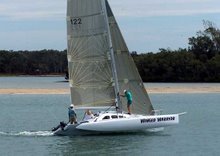I was going to do the main hull now, but went for the beams instead as I want to paint the floats now. So I can paint floats in the new workshop, and do beams in the old. I like to do more than one thing at the time, to be able to do different kinds of work, or spread out more nasty jobs , like sanding.
 First a jig is build.
First a jig is build. In center is the recess for upper folding strut (UFS).
In center is the recess for upper folding strut (UFS). The surplus of the chipboard is used to for another jig used for making upper corner and the top of the beam.
The surplus of the chipboard is used to for another jig used for making upper corner and the top of the beam. The corners are heat formed as described earlier on this blog (see floats).
The corners are heat formed as described earlier on this blog (see floats). A flange is formed. More on this later.
A flange is formed. More on this later. I have to do this for 4 beams as with all processes when building your own beams.
I have to do this for 4 beams as with all processes when building your own beams. Also these parts will be needed. Fiber bearings for UFS. ( why is the circles carbon? Because I had a nice pro-made piece at hand, thats why!)
Also these parts will be needed. Fiber bearings for UFS. ( why is the circles carbon? Because I had a nice pro-made piece at hand, thats why!)


























